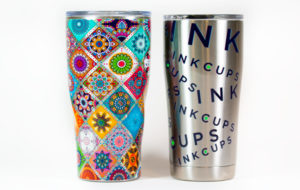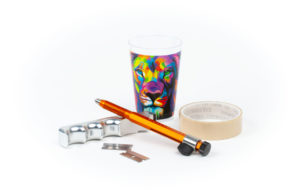- Equipment
- Inks & Supplies
- Services
- Applications
- Tagless
- Resources
- About Us
- Contact Us

Each company has unique needs for their printed products. Learn how ink testing is conducted to ensure that the ink adheres properly to glass, plastic, metal, and other substrates under a variety of conditions.
John Maher: Hi, I’m John Maher, and I’m here today with Matthew Macioci, Digital Sample Technician at Inkcups, the leading supplier and manufacturer of industrial inkjet printing equipment, pad printing equipment, inks, and accessories. Today we’re talking about testing methods for different substrates. Welcome, Matt.
Matthew Macioci: Hey John. How’s it going?
John: Good. What is a substrate and how many different types of substrates are there that you might print on?
Matthew: Sure, that’s a great question. Substrates are typically just a word for the outside layer of an object, and most of the substrates that we test on are glass. They’re limited to glass and plastic-coated metals, so powder-coated or anything like that.
John: Does the metal have to be coated in order for an ink to adhere to it or are there different types of metals?
Matthew: Typically, stainless steel is the metal that most companies will use. Sometimes it’ll be aluminum, which would require a different pre-treatment method, but they don’t need to be coated in order for them to be compliant with our inks. It’s just a matter of us finding the fine-tuned pre-treatment process that would work for that item.

John: And that’s typically what you’d find, like you said, a stainless steel type of product that somebody is using for a promotional item or for glassware or something like that?
Matthew: Correct, yes.
John: Okay. What are the general testing methods that you use for adhesion of inks to a substrate?
Matthew: General testing methods are abrasion resistance methods, which are varying degrees [of testing], going from mild to extreme, whether an ink can stay on a substrate. Customers want to know this because they want to know where they stand with what their product is and how the ink is going to stick to their product once it’s on there.
John: They’d want to know that because their product is being used in a certain way, and they want to make sure that when it’s used in a typical fashion by a consumer, that the ink is not going to wear off.
Matthew: Yes. We just had a customer here that one of their products is a really outdoors-y product, and they want to make sure that if it gets dropped or if it’s beat up and kicked around, they want to know that they [can] be confident in our ink and in our solution that it’s not going to come off right away, or it’s not going to come off with the scratch of a nail, or when it hits a rock or something like that.
John: Right. Which would be different from a product that’s going to typically be used in an office situation or something like that where it’s not going to be falling and hitting the rocks.
Matthew: Yes, absolutely. We [work with companies that don’t] require the same recommendations or specifications for adhesion as say this other company where their product is outside all day and needs to be really weather resistant.
John: Right. Why do people typically ask for a particular testing method, or what is it that they’re hoping to get out of that testing?
Matthew: That’s a great question. Typically, they are looking to get out of the testing what needs to be involved in [printing on] this bottle. Every company that comes to us needs to know that when we have these products in our hands, they also want to know what needs to go into those products to make it a feasible machine purchase for them. If they’re looking at some type of pre-treatment for their object, and they don’t want to go down that route, then maybe this isn’t what they need to do. Looking at that, it’s just a little eye opening because some customers will be very resistant to pre-treatments and things like that, so they just need to know a little bit more information about the product. And that’s why they do that.

John: Okay. What are some of the common substrates, and how are they tested? You mentioned glass, plastic, a couple of different types of metals, like stainless steel and aluminum. Does the testing method change depending on what kind of substrate you’re using, and what are the methods that you use for each one of those?
Matthew: It more so depends on what the customer is asking for. A customer can have a glass object, and another customer could have a plastic object. They could both ask for the same adhesion criteria. It’s just a matter of where they need to be, and what they need to pass for their product.
John: Okay. It’s really more product specific than it is about the substrate itself?
Matthew: Correct.
John: Okay. Then what is the ASTM testing standard?
Matthew: That’s just a standardized test that groups our adhesion testing altogether. When we have a customer [come] in, and they want to know what our adhesion testing is and basically what our baseline is for what passing is and what failing is, that’s what we tell them. It’s a standardized test. So it’s typically companies [who] will be knowledgeable of this.
John: Right. Those standardized tests are out there so that when you’re doing testing and another company is doing testing, it’s the same test done and the same method, the same way with the same criteria of whether or not it passes and fails, so that if you get one product tested at one company and another product tested at another company, you’re not talking about apples and oranges. They’re the same.
Matthew:Correct. It’s a common language when you’re speaking about that. Yeah.
John: All right. Well, thanks again for speaking with me today, Matt.
Matthew: No problem. Thank you for having me.
John: And for more information about Ink Cups and Ink Cups printing equipment, visit the website at inkcups.com or call (978) 646-8980.
Additional Resources:
Back to Blog Home
Add Your Comment